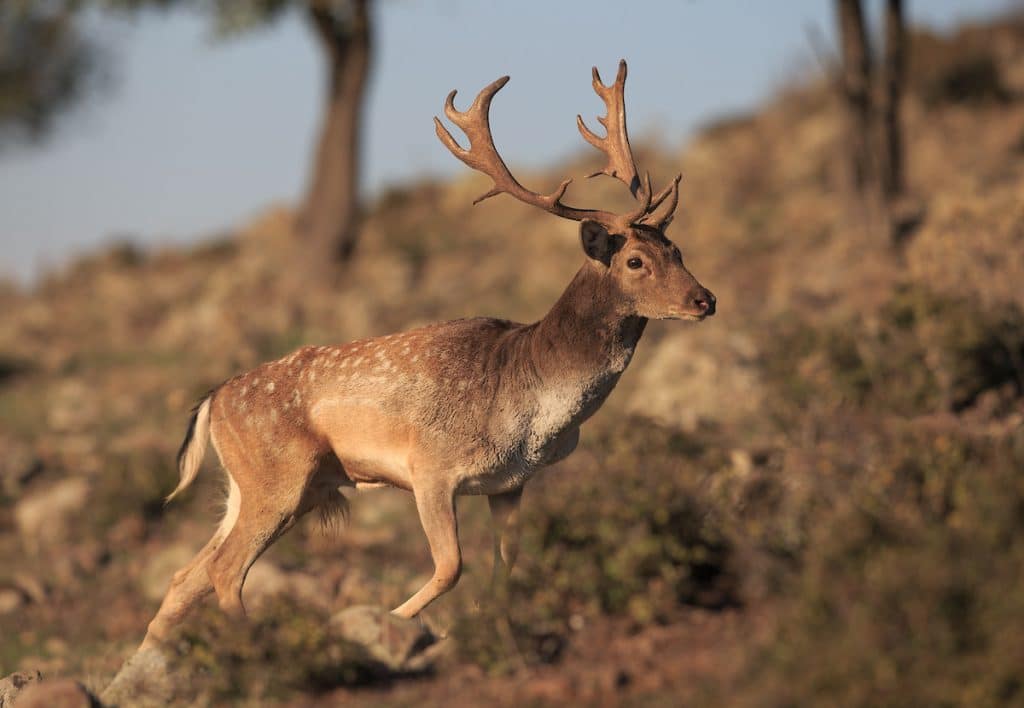Here in Sussex, we are able to enjoy seeing fallow deer roaming in our countryside. In fact, we have too many for they’re devastating our ancient woodlands and much of the wildlife that exists within them. The problem here is growing, there being no natural predators (centuries ago lynx, wolves) in the British Isles except for Man, but there being no nationally organised control programme of their numbers. The recent Covid induced closure of restaurants has even exasperated the situation, for there is a greatly reduced market for deer stalkers to sell to. So the following news from the Rewilding Europe organisation appears rather like the ‘flip of the coin!’ –
“More than 70 fallow deer will be released in the Rhodope Mountains rewilding area in Bulgaria over the 2020/2021 winter period. As part of the long-term restoration of deer populations in the Rhodope Mountains of Bulgaria and Greece. The animals will revitalise food chains, create more functional ecosystems and boost nature-based tourism.

BOGDAN BOEV
Restoring natural processes. Rewilding works to recover and enhance natural processes, such as the free movement of rivers, natural grazing, predation and scavenging. Restoring these processes often requires the reintroduction and restocking of missing or degraded wildlife populations. This, in turn, helps to create more resilient, fully functioning ecosystems, which are more capable of delivering a wide range of benefits to people, such as clean water, flood protection and the locking up of atmospheric carbon.
In the Rhodope Mountains rewilding area in southern Bulgaria for example, the restocking of fallow and red deer herds is supporting both predation and scavenging. Local wolf populations prey on the deer, which boosts the availability of wild carcasses for the area’s endangered vulture species, thereby helping to close the so-called ‘Circle of Life.’ Since last November the local rewilding team have released 67 fallow deer, with more fallow deer scheduled for release in the next few weeks and later in the year. More than 400 fallow deer and 50 red deer have already been released over the last five years by the team, in co-operation with local hunting associations.
Establishing viable populations. Fallow deer were once widespread in Bulgaria. Having been hunted to extinction in the country in the early Middle Ages, population restoration began in the middle of the twentieth century. If restored populations were allowed to grow naturally, the eastern Rhodope Mountains could support thousands of fallow and red deer in the near future.
Red and fallow deer populations both need to contain at least 50 adult animals to be viable. To date, restocking efforts by the Rhodope Mountains rewilding team have established three viable and growing populations of fallow deer, and one rapidly growing red deer population (the last red deer release was in 2018). When this fallow deer restocking period is finished, all deer populations will be allowed to develop of their own accord. While the three fallow deer populations will not be connected at first, natural growth should see them eventually connect and cover the entire Eastern Rhodopes.
Wide-ranging benefits. The Rhodope Mountains rewilding area is one of the last strongholds of the griffon vulture in Europe and is home to the only indigenous population in Bulgaria. Cinereous vultures from the only Balkan colony in Greece also frequent the area in search of food. Both cinereous and griffon vultures are currently supported by artificial feeding stations in the Bulgarian and Greek parts of the Rhodope Mountains, although the aim is to discontinue this practice when there is sufficient natural food available to support the birds. The restocking of deer populations is a step towards this.
The biological diversity of the Rhodope Mountains is one of the richest areas within Europe. Natural grazing by free-roaming wild herbivores such as fallow and red deer helps to maintain and enhance this diversity by creating and maintaining half-open, half-wooded landscapes. The reintroduction of deer species also boosts the appeal of the Rhodope Mountains as a destination for nature-based tourism, which allows local entrepreneurs and communities to benefit economically from the restoration of wild nature.”
(A few years ago in 2015, I was lucky enough to be able to see a little of this amazing area in Bulgaria, we hiring a local wildlife expert to explore part of it).
